High yield and large fruits with a delicate taste: the Eagle Heart tomato - how to grow it yourself without hassle
Seeds of a wide variety of tomatoes are sold at gardening markets. Among them, large pink tomatoes occupy a special place. They are most popular due to their juiciness, meatiness and rich taste. These are the berries that are best suited for making salads and tomato sauces.
One of the most beautiful pink tomatoes is Eagle Heart. This variety is distinguished not only by the rich taste of the fruit, but also by its unusual heart-shaped shape. It is not difficult to grow these tomatoes in your garden. The main thing is to know the basic rules and nuances of caring for them.
Description of the variety
Eagle Heart is a tomato variety bred by domestic breeders from Siberia. Its originator is Dereko Vladimir Nikolaevich.
The variety was developed in 2003. In 2005, it was registered in the Russian register of selection achievements.
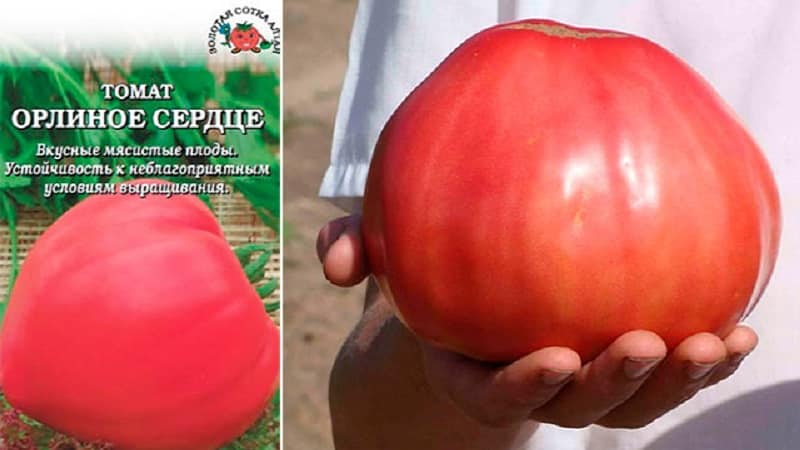
Tomato is actively grown by gardeners in all countries of the former CIS. Its seeds can also be found in online stores in Europe.
Distinctive features
The main feature of the Eagle Heart is its unusual fruits.. They have a rich pink color, and the shape resembles a heart or large garden strawberry. The variety is also impressive for its size. The weight of individual berries reaches 1 kg. Moreover, all the tomatoes on the bush turn out to be large. The taste of Eagle Heart is rich, sweet, with slightly pronounced sourness.
This type of tomato rarely causes allergies. It is recommended for baby food.The fruits contain lycopene, which helps cleanse the body of waste, toxins, free radicals and bad cholesterol, and iodine, which is necessary for the normal functioning of the thyroid gland.
The bush is indeterminate and tall, so gartering and pinching are necessary.
Like all varieties of Siberian selection, Eagle Heart is resistant to temperature changes. Tomatoes are grown in open and protected ground.
Important! The downside of this variety is that it is demanding on soil composition. The gardener will have to constantly fertilize, monitoring the amount of nitrogen fertilizer.
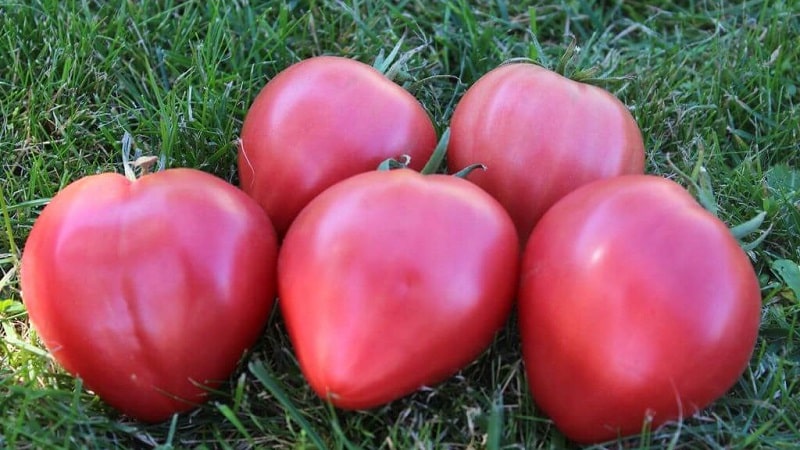
Main characteristics
The Eagle Heart tomato is planted by gardeners all over the world. Its main characteristics and description of the variety are given in the table.
| Parameter | Indicators |
| Bush type | Indeterminate (it stops growing on its own after the formation of the upper inflorescence). The height of the bush varies between 100-150 cm. The plants are heavily leafy. The stems are powerful and durable. The leaves are dark green in color and medium in size. They are slightly corrugated, without pubescence. The inflorescences are simple. Seeds are planted at a height of 6-7 leaves. The fruits are collected in tassels, 3-4 pieces each. |
| Growing method | In regions with warm climates, the variety is grown in open ground. In central Russia, it is advisable to use film greenhouses. In cold regions, tomatoes are planted in a greenhouse. |
| Productivity | High. From 1 sq. m harvest up to 14 kg of crop. |
| Fruit | Big ones. On average, their weight varies between 300-600 g. The weight of record specimens exceeds 1 kg. The color of the berries is raspberry inside and out. There is no green spot at the base, but some fruits have yellow areas around the stalk. The shape of the fruit is heart-shaped with a long elongated tip.Medium ribbing is present throughout the entire area. The taste of the berries is sweet, with slightly sourness. There is a lot of pulp and it is juicy. There are few seed chambers (on average 3-4). |
| Transportability | Average. The skin is thin but durable. The berries crumple when subjected to mechanical stress. Stored for a month. |
| Ripening time | Mid-season tomato. The first berries ripen 100-115 days after sowing the seeds. Fruiting continues all summer. |
| Disease resistance | It is resistant to tomato diseases. |
How to grow seedlings
Mid-season tomatoes are grown in seedlings. Seeds are sown 55-65 days before their intended planting in a permanent place.
Usually, seeds are sown in early May. These terms are suitable for all regions, since in cold cities tomatoes of this variety are grown in a greenhouse.
Advice. Gardeners believe that the best seedlings are those grown in a heated greenhouse. It is in such conditions that it is possible to grow strong and stocky plants.
Seed treatment
Before sowing planting material, the seeds need to be prepared. Many manufacturing companies do this in the factory. If you use seeds from your own harvest or there is no information on dressing on the packaging, then the procedure is carried out at home.
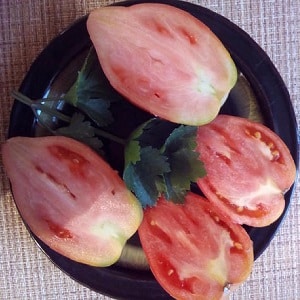 How to prepare seeds for sowing:
How to prepare seeds for sowing:
- Before use, planting material is sorted. Damaged and darkened seeds are removed.
- Seeds are soaked in salted waterprepared from 1 tsp. salt and a glass of water. Those specimens that have sunk to the bottom are suitable for planting.
- Planting material is disinfected. It is soaked in a light pink solution of potassium permanganate or hydrogen peroxide for 20 minutes.Another option is to soak the seeds in aloe juice or soda solution (1 teaspoon of soda per 1 cup of water). After etching, the planting material is washed under running water.
- Stimulation of growth. The easiest way to do this is to soak the seeds in one of the following products: Epin, Sodium Humate, Zircon, aloe juice, soda solution. Another option is to keep the seeds in the refrigerator for 3 days before planting, and then keep them for another two days in a piece of cloth moistened with warm water.
Other varieties of tomatoes:
A good choice for a picky summer resident is the Peter the Great tomato.
A little about containers and soil
Eagle Heart grown both in individual containers and in common boxes.
If you plan to grow a large number of seedlings, it is more convenient to sow the seeds first in one large container (boxes, trays, packages of cakes and semi-finished products, cut bottles), and then plant the already grown plants in individual pots with a volume of at least 300 ml.
Advice. To prevent tomato roots from becoming tangled and damaged when picking, some gardeners divide the box into cells with cardboard or plastic partitions. One seed is sown in each of them.
When growing several tomato bushes, it is more advisable to use peat tablets. In this case, seedlings will not need picking.
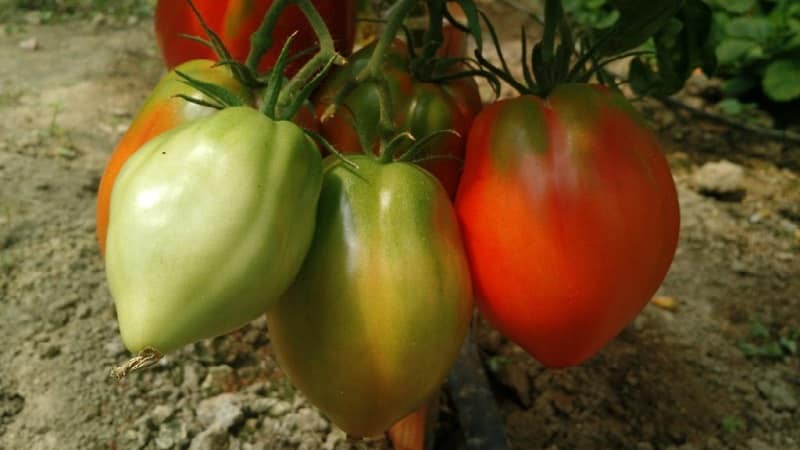
All containers are treated with a disinfecting solution. They are soaked in boiling water, copper sulfate (0.5 tsp per 2 liters of water) or a dark pink solution of potassium permanganate.
Stores sell special soil for tomatoes and universal soil for seedlings. Both options will do.
There are many recipes for making your own soil mixtures.. The most popular option is to combine chernozem and peat in equal proportions, adding 0.5 parts of sand to them. A bucket of such soil is mixed with a glass of ash.
The soil is also disinfected. It is poured with boiling water, copper sulfate or a dark pink solution of potassium permanganate.
Sowing planting material
A layer of soil is poured into the boxes and watered with warm water.. Grooves 1 cm deep are made in the soil at a distance of 3 cm. Seeds are placed in them at a distance of 2 cm from each other.
Planting material is sprinkled with earth. Boxes with crops are covered with glass or film and placed in a warm place - for example, near a radiator.
Basic rules of care
Often, novice gardeners are afraid to grow seedlings on their own, preferring to buy tomatoes ready for planting in a permanent place on the market. Quality plants are recognized by their bright green foliage, short internodes, strong stem and stockiness.
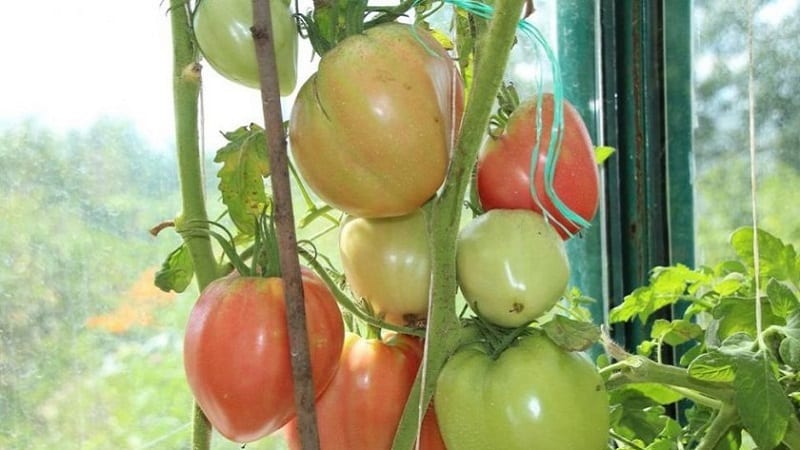
When buying seedlings on the market, it is impossible to accurately determine whether the seller is offering the right variety. It is much safer to grow seedlings yourself. Moreover, it is easy to do, the main thing is to follow the rules of care:
- After all the seeds have sprouted, the film is removed. Tomatoes are moved to a cool place for a week. This will prevent them from being pulled out. Then they are brought into the room.
- Important provide 16 hours of daylight for seedlings. Experienced gardeners use fluorescent lamps. This reduces the risk of plants being pulled.
- Watering the plants as the topsoil dries out. It is important to moisten only the soil so that the liquid does not get on the green tomatoes. Use warm water.
- Tomatoes are diving during the formation of the third true leaf. Two weeks after this procedure, the plants are fed.
- Feeding seedlings during the entire growing period three times with an interval of two weeks. Use special preparations for seedlings (“Strong”, “Solution”) or a product prepared from a bucket of water, 1 kg of chicken manure, 1 tbsp. ash.
- 10 days before the pick Tomatoes begin to be hardened to a permanent place by taking them out onto the balcony in the warm season.
Seedlings should not be placed in a draft, otherwise the plants will freeze and die. If the plants begin to lose turgor, you should make sure that they are watered correctly.
Read also:
Exotic taste and amazing appearance - Irish Liquor tomato
An exotic variety with a unique appearance - the Gargamel tomato
How to grow tomatoes
Tomatoes are planted in a permanent place in May. Before this, the seedlings are watered and fed. This will help them quickly settle into a new place and will be easier to remove from the container.
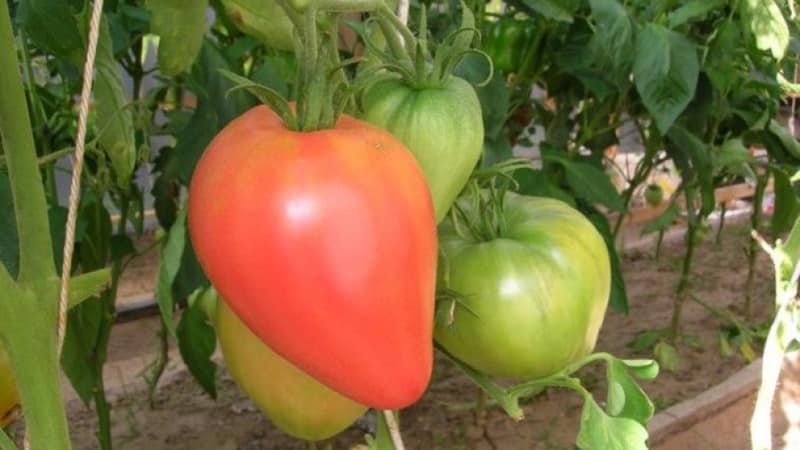
Planting seedlings in a permanent place
For tomatoes, choose a place well lit by the sun.. No other nightshade crops should grow in tomato beds for the last two years. The best precursors for tomatoes are legumes, melons and cabbage.
The selected area of the garden is dug up to the depth of one spade bayonet in the fall.. All plant debris is removed. The soil is mixed with fertilizers (6 kg of humus is taken per 1 sq. m). If the soil is too dense, sand is added to it. In case of high acidity, add dry lime or ash. In spring, the soil is leveled with a rake and cleared of weeds. The soil is watered with hot copper sulfate. To prepare the solution, pour 1 tbsp into a bucket of water. l. vitriol.
Holes for the Eagle Heart are dug in rows in a checkerboard pattern. For 1 sq. m place from 5-6 plants. Granular fertilizers are poured into the holes. 1 liter of light pink solution of potassium permanganate is poured into each of them. When the liquid is absorbed, plants are planted in the depressions along with a lump of earth. They are sprinkled with earth on top and the soil is compacted.
Caring for mature plants
Tomato Eagle Heart tall. It must be tied to supports or trellises. For this, a synthetic thread is used. If the fruit clusters are heavy, they are attached to additional supports.
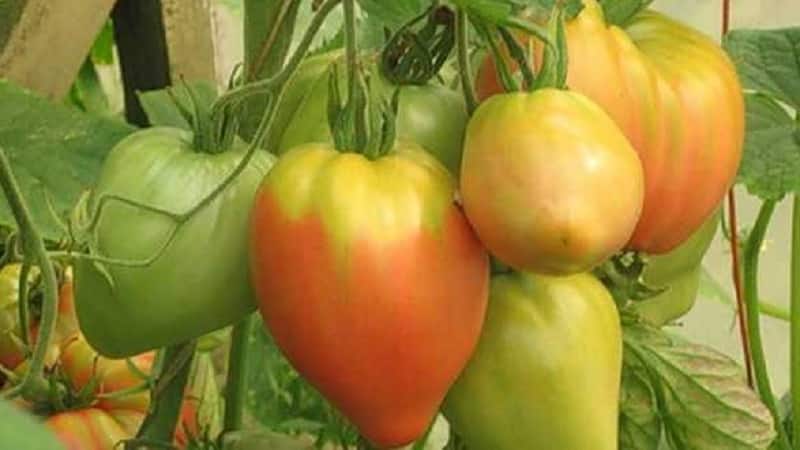
They form bushes with 1-3 stems. The fewer trunks, the larger the fruits will be. During the pinching process, excess leaves are removed. Cut off all the greenery at the bottom of the bush and withered leaves. The procedure is carried out once a week. No more than three leaves are removed at a time.
Eagle Heart beds need to be mulched. They are covered with rotted straw, hay or humus. This measure will not only protect the roots of the plants from freezing, diseases and pests, but will also serve as an additional fertilizer.
Water tomatoes as the soil dries out. Use 2-3 liters of warm, settled water per plant. The liquid should not get on the above-ground part of the tomatoes. After each watering, the beds are loosened, destroying the earthen crust. During this procedure, weeds are removed.
Fertilizers are applied every two weeks. Preference is given to phosphorus and potassium preparations. Nitrogenous fertilizers are applied less frequently. The bushes are sprayed with a solution of boric acid 2-3 times per season. Some gardeners use sweet water to attract pollinating insects.
Possible difficulties
When growing tomatoes Beginning gardeners often face a number of difficulties:
- Bushes shed ovaries and inflorescences. The most likely cause of this problem is excessively high nitrogen levels in the soil.
- Tomatoes do not set fruit well. Tomatoes are not pollinated. To solve the problem, the bushes are shaken regularly during flowering.
- Tomatoes do not tolerate feeding well. To prevent plant roots from being burned by fertilizers, the beds are watered abundantly before applying them.
- The fruits are cracking. This happens with excessive watering and due to the scorching sun.
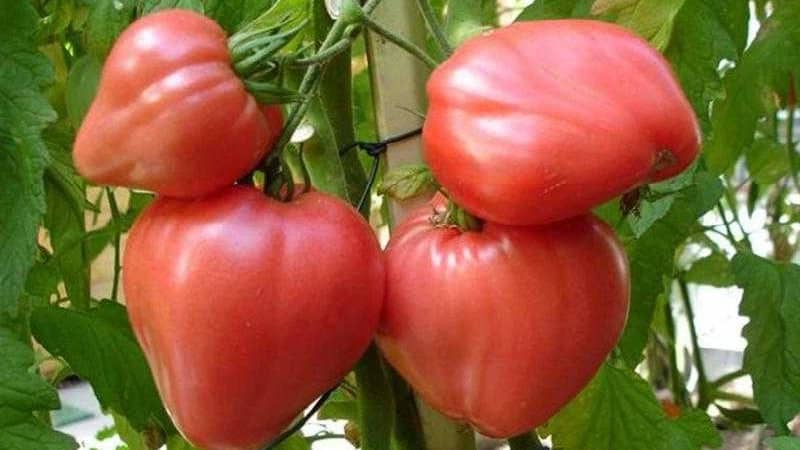
Diseases and pests
Eagle heart is resistant to most tomato diseases. Thanks to this, it is not necessary to spray the bushes with chemicals, which makes growing them much easier. However, despite the high immunity of the variety, experienced gardeners recommend following the rules of prevention. During an epidemic of late blight, the bushes are sprayed with a light pink solution of potassium permanganate.
To protect tomatoes from pests, they are sprayed once a week with a solution of laundry soap (1 piece of soap per bucket of water) or curdled milk (2 liters per 1 bucket of water). It is not recommended to use chemicals, as they reduce the usefulness of the fruit.
The nuances of growing in open ground and in a greenhouse
Before planting tomatoes, the soil in the greenhouse is completely changed.. Instead, a nutritious and light substrate with a high peat content is poured.
Water the beds in the greenhouse once a week, and in open ground three times. It is important to maintain optimal humidity in the room and ventilate it regularly.
In open ground tomato beds are covered with film at night. This will protect them from night frosts.
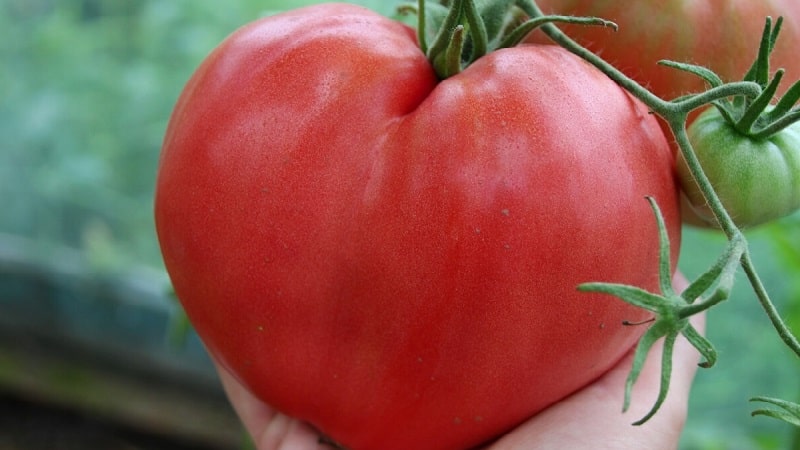
Harvesting and application
Tomatoes Eagle heart is harvested at the end of July. They are plucked from the bush one by one. The variety does not differ in its ripening speed.
Mostly Harvest consumed fresh. The berries are also suitable for making tomato juice.
Advantages and disadvantages of the variety
Benefits of Eagle Heart:
- high productivity;
- beautiful large fruits;
- meatiness and sweet rich taste;
- immunity to tomato diseases;
- possibility of using seeds for planting.
Disadvantages of the variety:
- increased demands on soil composition;
- the need for gartering and pinching.
Farmer reviews
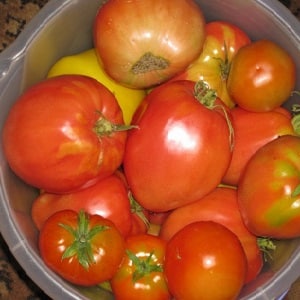 Feedback from farmers about Eagle Heart is positive. This variety has all the advantages declared by the manufacturer. Its fruits turn out beautiful and large, as in the photo.
Feedback from farmers about Eagle Heart is positive. This variety has all the advantages declared by the manufacturer. Its fruits turn out beautiful and large, as in the photo.
Elena, Tver: “I grew the eagle heart in a greenhouse. Formed into 1 stem. In the fall, rye was sown in the soil, which was dug up in the spring and watered with Baikal. After that, I applied fertilizer only twice during the season. The tomato was not sick. For late blight, I hung an open bottle of iodine in the greenhouse. The tomatoes grew gigantic and beautiful. The weight of the largest of them was 900 g.".
Irina, Krasnodar: “I have been planting Eagle Heart in open ground for several years now. Very beautiful tomatoes. They resemble large strawberries. The taste is sweet, the pulp is sugary. Ideal for salads. It can also be used for pickling and juices, but it’s a shame to spoil such beauty.”.
Conclusion
Even the most demanding gardeners will like the Eagle Heart tomato. The berries not only have a wonderful taste and sugary pulp, but also an attractive appearance. The yield of the variety is also high.
Growing such tomatoes is not difficult. Follow the rules of care and apply fertilizing in a timely manner, and then the harvest will not disappoint you.